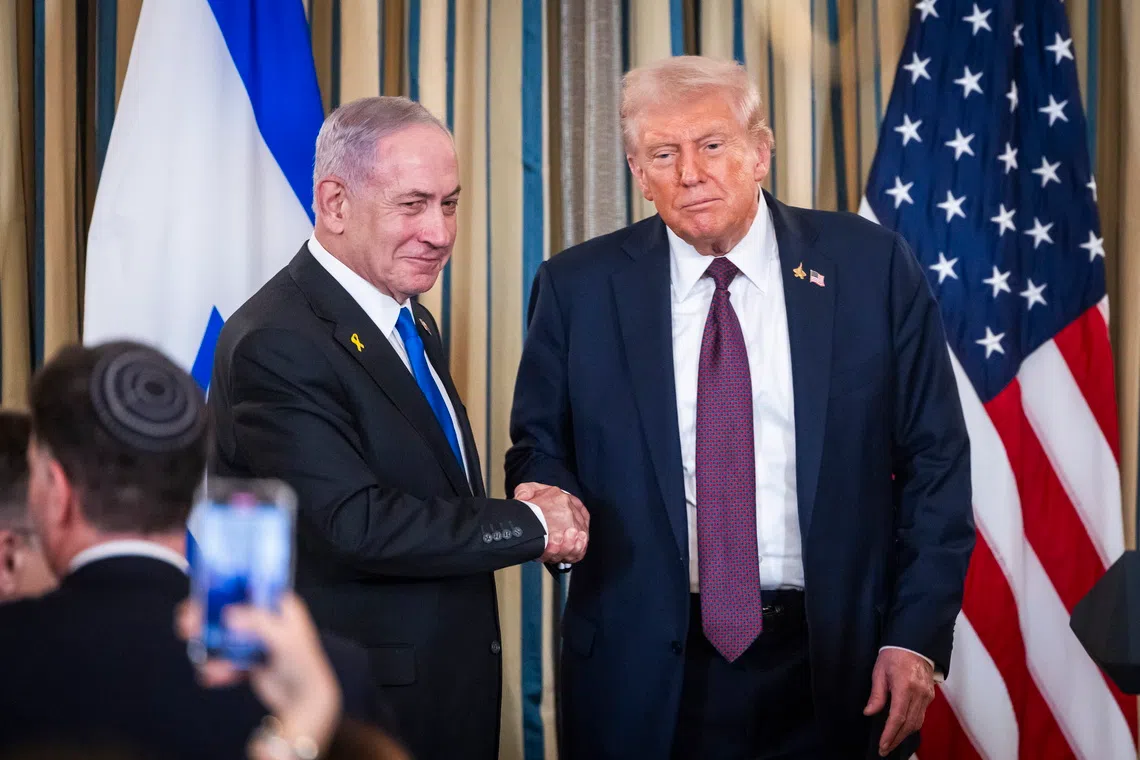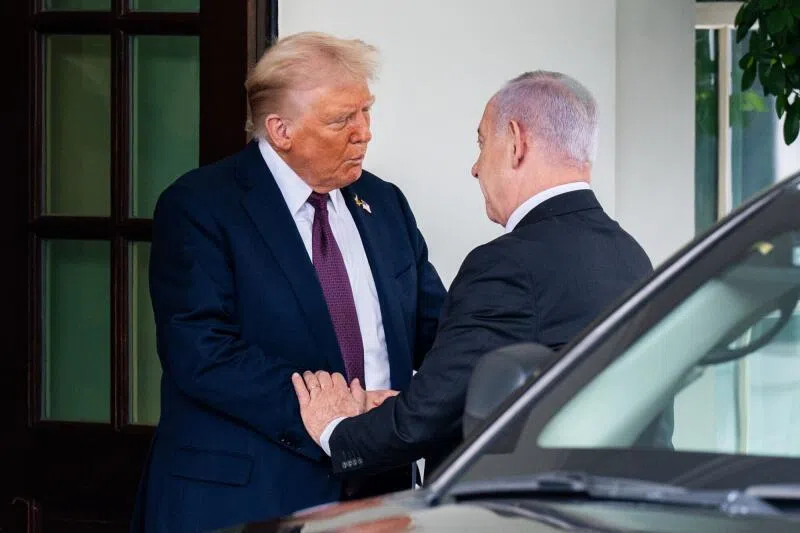Trump secures Netanyahu’s support for Gaza deal, but Hamas’ agreement still in question
Sign up now: Get ST's newsletters delivered to your inbox

Israeli Prime Minister Benjamin Netanyahu (left) and US President Donald Trump holding a joint press conference at the White House on Sept 29.
PHOTO: EPA
Follow topic:
- Trump and Netanyahu announced a 20-point plan to end the Gaza war, contingent on Hamas accepting terms and releasing hostages in 72 hours.
- The plan proposes a technocratic committee to govern Gaza, overseen by a "Board of Peace" chaired by Trump, excluding Hamas from governance.
- Key Muslim nations support the plan, but Hamas and Islamic Jihad reject it, while Gaza residents express scepticism; Israel's shekel rose sharply.
AI generated
WASHINGTON/CAIRO/JERUSALEM – US President Donald Trump has secured Israeli Prime Minister Benjamin Netanyahu’s backing for a US-sponsored peace proposal to end a nearly two-year-old war in Gaza, but questions loomed over whether Hamas would accept the plan.
Speaking at a joint White House press conference on Sept 29 after a meeting with Mr Netanyahu, Mr Trump said they were “beyond very close” to an elusive peace deal for the Palestinian enclave.
But he warned the militant group Hamas that Israel would have full US support to take whatever action it deems necessary if the militants reject his offer.
The White House released a 20-point document
Mr Trump said the framework had the support of other leaders from the Middle East and Muslim-majority nations
The US leader went into the Sept 29 meeting seeking to overcome Mr Netanyahu’s misgivings over parts of the plan. It was not immediately clear whether the Trump administration and Israel had resolved all their differences, including over the possibility of a future Palestinian state – which Mr Netanyahu has forcefully rejected – and any role for the Palestinian Authority in the post-war governance of the enclave.
Mr Trump thanked Mr Netanyahu “for agreeing to the plan and for trusting that if we work together, we can bring an end to the death and destruction that we have seen for so many years, decades, even centuries”.
Standing next to Mr Trump, Mr Netanyahu responded: “I support your plan to end the war in Gaza, which achieves our war aims. It will bring back to Israel all our hostages, dismantle Hamas’ military capabilities, end its political rule, and ensure that Gaza never again poses a threat to Israel.”
It was clear, however, that Hamas remained the key to whether Mr Trump’s peace proposal would get off the ground.
The group’s absence from negotiations and its previous repeated refusals to disarm raised doubts about the plan’s viability.
Hamas, which triggered the war with its Oct 7, 2023, attack
“Hamas hasn’t yet received the plan officially, nothing beyond media publication,” a Hamas official told Reuters.
But an official briefed on the talks later said Qatar and Egypt shared the document with Hamas, which told mediators it will review it “in good faith” and then respond.
In Mr Netanyahu’s fourth White House visit since Mr Trump returned to office in January

US President Donald Trump (left) greeting Israeli Prime Minister Benjamin Netanyahu at the White House on Sept 29.
PHOTO: EPA
Mr Trump sharply criticised the recognition of statehood as a prize for Hamas.
The Sept 29 meeting marked a stepped-up diplomatic effort by the US President, who vowed during the 2024 presidential campaign to quickly end the conflict and has since repeatedly claimed that a peace deal was near, only for it to fail to materialise.
Washington outlined its peace plan to Arab and Muslim states on the sidelines of the UN General Assembly last week.
Mr Trump presented his set of proposals in effusive terms on Sept 29 but ended what was billed as a press conference without taking questions. He has previously hailed international deals that delivered less than promised.
He headed into an August summit in Alaska with Russian President Vladimir Putin seeking a ceasefire in the Ukraine war and emerged with no such deal
Mr Netanyahu, while praising Mr Trump as a friend of Israel, distanced himself from some items in Mr Trump’s plan, including the reforms being demanded of the internationally recognised Palestinian Authority and the prospects for eventual Palestinian statehood.
The Palestinian Authority welcomed Mr Trump’s efforts on Sept 29 and reiterated its commitment to work with the US and its partners to reach a comprehensive deal, news agency Wafa reported.
Mr Netanyahu is under mounting pressure from the hostages’ families and, according to public opinion polls, a war-weary Israeli public. But he also risks the collapse of his governing coalition if far-right ministers believe he has made too many concessions for a peace deal.
Mr Steven Cook, a senior fellow of the Council on Foreign Relations think-tank, said an end to the war may be closer but cautioned that further work was needed. “The Qataris now must put the screws to Hamas and Netanyahu needs to sell to his security Cabinet,” he said.
Hamas-led fighters killed around 1,200 people and captured 251 hostages in the Oct 7 attack on Israel, according to Israeli tallies.
More than 66,000 Palestinians have since been killed in Israel’s assault, according to the Gaza health authorities.
Much of Gaza in ruins
Israel launched one of its biggest offensives of the war in September, with Mr Netanyahu saying he aims to wipe out Hamas in its final redoubts. The war has left much of Gaza in ruins and caused a major humanitarian crisis.
The US plan, crafted by special envoy Steve Witkoff and Mr Trump’s first-term Middle East adviser, Mr Jared Kushner, envisions a ceasefire followed by the release within 72 hours of all remaining hostages in exchange for hundreds of Palestinian prisoners, along with the gradual withdrawal of Israeli forces.
It outlines a vague path towards Palestinian statehood once Gaza’s redevelopment is well under way and the Palestinian Authority undertakes reforms, but it does not provide further details.
The question of eventual Palestinian statehood, which Mr Netanyahu has vowed never to let happen, was among the main sticking points to the Israeli leader’s acceptance of the initiative, according to a source close to the talks.
Under the plan, the US will work with Arab partners and other international parties to develop a temporary stabilisation force to oversee security.
Gaza will be governed without Hamas’ involvement and with initially only a limited role for a Palestinian Authority “representative”. Mr Netanyahu has said the Palestinian Authority must not control the territory.
The proposal calls for the creation of a technocratic Palestinian committee responsible temporarily for day-to-day Gaza services, overseen by an international “board of peace” chaired by Mr Trump and including former British prime minister Tony Blair, the White House said. REUTERS

